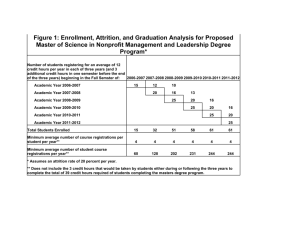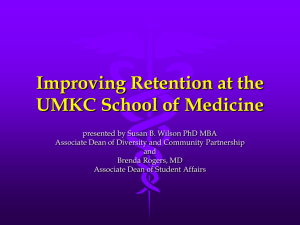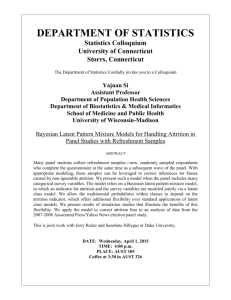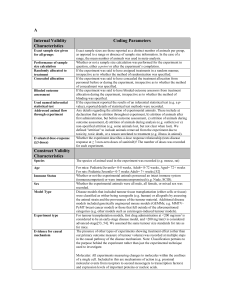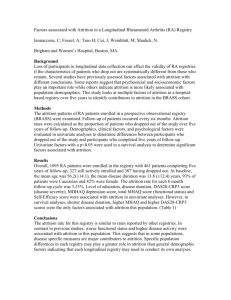document title second line and third line
advertisement
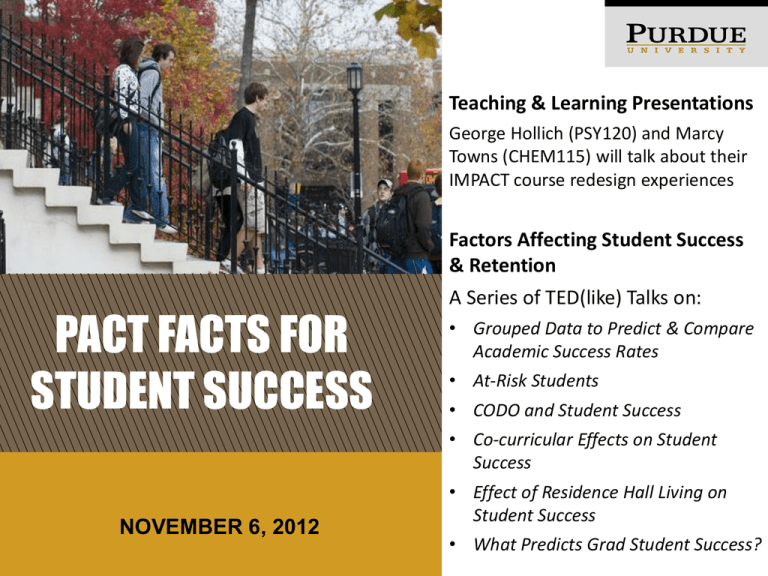
Teaching & Learning Presentations George Hollich (PSY120) and Marcy Towns (CHEM115) will talk about their IMPACT course redesign experiences PACT FACTS FOR STUDENT SUCCESS Factors Affecting Student Success & Retention A Series of TED(like) Talks on: • Grouped Data to Predict & Compare Academic Success Rates • At-Risk Students • CODO and Student Success • Co-curricular Effects on Student Success NOVEMBER 6, 2012 • Effect of Residence Hall Living on Student Success • What Predicts Grad Student Success? Brent Drake, EMAR Brenda Schroeder, Advising Andy Zehner, Student Affairs FACTORS AFFECTING STUDENT SUCCESS & RETENTION AT PURDUE Kevin Maurer, Housing & Food Services Phil Pope, Graduate School November 6, 2012 GROUPED DATA BRENT DRAKE, ASSISTANT VICE PROVOST & DIRECTOR ENROLLMENT MANAGEMENT ANALYSIS & REPORTING GROUPED DATA PREDICTIONS MULTIPLE CORRELATIONS AT SINGLE INSTITUTION Multiple correlations between measures of academic success and unit level student entering academic profiles at one institution tend to lead to correlations of low to moderate effect sizes (Bridgeman, McCamley-Jenkins, & Ervin, 2000) Some reasons identified in the literature (Stumpf & Stanley, 2002) • • • Restriction of range inherent in any one institutions academic profile The interdependence of academic profile variables from high school transcripts and standardized tests The disparate academic experience of students in one institution GROUPED DATA PREDICTIONS SOLUTION BASED ON NATIONAL SAMPLE Based on Stumpf and Stanley’s 2002 article use grouped data items readily available in two national data sets • Integrated Post-Secondary Education Data System (IPEDS) – 25th and 75th percentile of SAT Scores • US News and World Report National Colleges data set – Percentage of students in top ten percent of high school class Criterion variable was six-year graduation rates pulled from IPEDS Final data set consisted of 199 institutions Multiple correlation for model R2 = 0.8025 distinguishing between graduation rates at different institutions GROUPED DATA PREDICTIONS PURDUE RESULTS Use national model at university level to predict success among different subgroups • how well are individual colleges performing versus their predicted performance Overall, Purdue outperforms its predicted rate • Most recent US News Report showed Purdue as a four percentage point over performance as well The majority of the colleges on the campus over perform as well • Wide range in performance (-6.75 to +38.88) AT SECTION RISK STUDENTS TITLE BRENT DRAKE, ASSISTANT VICE PROVOST & DIRECTOR ENROLLMENT MANAGEMENT ANALYSIS & REPORTING SURVEY RESULTS AT RISK STUDENTS Freshmen students surveyed at end of their first year • • Questions asked about likelihood of persistence, graduation, and commitment to determine students risk of returning Purdue has administered last 6 years 52.0% 51.2% Academic factors 44.6% 23.7% 26.2% 20.8% Financial factors 20.4% 20.2% Campus environment 29.2% 3.9% 2.4% 5.4% Advisement/support services 0% 10% 20% 2012 2010 30% 2008 40% 50% 60% ACADEMIC FACTORS AT RISK STUDENTS 10.4% I am not challenged enough academically 46.4% 12.1% The academic work load is more than I want 39.3% 56.9% 34.3% 28.6% 32.8% I am interested in an academic program at another institution The academic program does not match up with my career goals 25.0% 20.7% 40.3% 14.9% 17.9% 17.2% I’m having trouble getting the major I want 0% 2012 64.2% 10% 2010 20% 2008 30% 40% 50% 60% 70% AT RISK STUDENTS FINANCIAL FACTORS 43.8% 39.3% 44.4% I think I can get the same level of education for a better price elsewhere I need to go to an institution that is significantly less expensive than Purdue even if it means getting a lesser education 25.0% 25.0% 24.4% 18.8% I feel that I cannot afford the cost of attending any school at this time 28.6% 26.7% 12.5% I think I can get a better education for the same price elsewhere 7.1% 4.4% 0% 2012 5% 2010 10% 15% 20% 25% 30% 35% 40% 45% 50% 2008 CAMPUS ENVIRONMENT AT RISK STUDENTS I would prefer to have more social opportunities 50.0% 50.0% 40.0% I would prefer a school with fewer students 68.0% 50.0% 55.3% 28.0% 33.3% 21.1% I would prefer more economic diversity 16.0% 21.1% I would prefer more racial and ethnic diversity 33.3% 24.0% 16.7% 10.5% I don’t like living in the city 16.0% 16.7% 13.2% I would prefer a school with more students 0% 2012 10% 20% 30% 40% 50% 60% 70% 80% 2010 2008 CODO-IN SURVEY SECTION TITLE BRENDA SCHROEDER, ACADEMIC ADVISING ASSESSMENT TEAM CODO-IN SURVEY ACADEMIC ADVISING ASSESSMENT TEAM The Goal of the Academic Advising Assessment Team is to gain a better awareness and understanding of the strengths and weaknesses of advising at Purdue. Ultimately, it is the team's hope that this process will help improve advising on campus. CODO-IN SURVEY SURVEY INSTRUMENT • Given to all students who CODO • Designed to collect information on: –how students are CODOing, –why they are CODOing, –how they are selecting their majors RESOURCES CODO-IN SURVEY Resources for Learning CODO-IN Requirements (CODO- Change of Degree Objective/Change of Curricula) 500 450 400 350 300 250 200 150 100 50 0 2008 - Spring 2008 - 2009 2009 - 2010 2010 - 2011 Examples Other: Advisors, Ivy Tech Community College, Krannert, Laying Tracks, Own Research, Walk-Ins Courses: AGEC 20300, AGEC 33100, CDFS 21000, COM 11400, COM 25000, EDPS 10500, EDPS 20000, GS 11900, HIST 15100, MGMT 10000, OLS 25200, OLS 27400, PHPR 10000, PSY 22200, SOC 10000 INFLUENCERS CODO-IN SURVEY Factors Influencing CODO Decision (CODO – Change of Degree Objective/Change of Curricula) 900 800 700 600 500 400 300 200 100 0 Spring 2008 2008 - 2009 2009 - 2010 2010 - 2011 GPA OF CODO STUDENTS CODO-IN SURVEY Current Overall GPA 350 300 250 200 150 100 50 0 4.00 3.50 - 3.99 2008 - Spring 3.00 - 3.49 2008 - 2009 2.50 - 2.99 2.00 - 2.49 2009 - 2010 1.50 - 1.99 2010 - 2011 1.49 or less DEMOGRAPHICS OF CODO STUDENTS CODO-IN SURVEY Gender 700 600 500 400 300 200 100 0 2008 - Spring 2008 - 2009 2009 - 2010 Female 2010 - 2011 Male Ethnicity 1000 800 600 400 200 0 African American 2008 - Spring American Indian Asian American 2008 - 2009 Caucasian American 2009 - 2010 Hispanic American Other 2010 - 2011 WHERE DO THEY CODO TO? CODO-IN SURVEY CODO-IN College/Program/School 500 450 400 350 300 250 200 150 100 50 0 2008 - Spring 2008 - 2009 2009 - 2010 2010 - 2011 WHERE DO THEY CODO FROM? CODO-IN SURVEY CODO-OUT College/Program/School 300 250 200 150 100 50 0 2008 - Spring 2008 - 2009 2009 - 2010 2010 - 2011 CODO-IN SURVEY THREE EXPECTATIONS OF ACADEMIC ADVISOR CO-CURRICULAR ACTIVITIES & ACADEMIC SECTION SUCCESS TITLE ANDY ZEHNER, ASSESSMENT & DATA ANALYST STUDENT AFFAIRS Students who do both, do best CO-CURRICULAR ACTIVITIES PURDUE STUDENTS ALL GRADE CLASSIFICATIONS 3.40 3.30 3.20 3.10 3.00 2.90 2.80 Engaged Purdue 2.70 2.60 1 2 3 4 Semester 5 6 7 8 CO-CURRICULAR ACTIVITIES STUDENT PERFORMANCE BY COLLEGE Average GPA Average Credits Earned Pct. 3/15 College or School Engaged Purdue Engaged Purdue Engaged Purdue College of Liberal Arts 2.99 2.80 15 14 41.5% 34.1% First Year Engineering 3.09 2.89 18 16 55.1% 42.8% College of Science 3.10 2.92 16 14 50.0% 36.2% College of Health & Human Sci 3.25 3.08 16 15 55.0% 42.4% College of Technology 3.15 2.85 16 14 53.4% 36.4% College of Agriculture 3.09 2.83 16 15 48.6% 38.6% School of Aero and Astro Engr 3.05 2.79 16 13 43.9% 31.3% School of Management 3.18 2.99 16 15 51.4% 45.2% CO-CURRICULAR ACTIVITIES WHAT IS THE RELATIONSHIP? • Academic success co-varies with engagement • Academic success is subsequent to engagement • Engagement promotes academic success CO-CURRICULAR ACTIVITIES HOW DOES ENGAGEMENT PROMOTE ACADEMIC SUCCESS? • Most engaged students are excellent to begin with • Engagement imposes order & discipline • Getting involved caps out-of-class activity • Expectations are high • Special tutoring is provided • Mens sana in corpore sano • Some course credits are relatively easy CO-CURRICULAR ACTIVITIES ACADEMICS IS PRIMARY FOCUS 31% OF SAO’S 900+ CLUBS/ORGANIZATIONS Non-academic, 450 Academic, 390 Mixed/ uncertain, 415 CO-CURRICULAR ACTIVITIES 3 OUT OF 5 STUDENTS DEVOTE LESS THAN 5 HRS/WK TO CO-CURRICULAR ACTIVITIES 40% Percent of respondents 35% 30% 25% Freshmen 20% Seniors 15% 10% 5% 0% None 1-5 hrs 6-10 hrs 11-15 hrs 16-20 hrs 21-25 hrs Over 25 hrs RESIDENCE HALLS AND SECTION STUDENT SUCCESS TITLE KEVIN MAURER DIRECTOR OF STRATEGIC INITIATIVES & ASSESSMENT HOUSING AND FOOD SERVICES UNIVERSITY RESIDENCES POPULATIONS LIVING ON CAMPUS University Residences is one of the largest collegiate housing operations in the nation • • Capacity of 11,779 No live-in requirement for students Fall 2012 Occupancy Single Undergrads Single Grads Families Total 92.2% of beginning students chose to live in UR for Fall 2012 10,696 265 622 11,583 35.6% of all undergrads chose to live in UR – Fall 2012 UNIVERSITY RESIDENCES POPULATIONS LIVING ON CAMPUS West Lafayette Undergraduate Students Living in University Residences 100% 75% 50% 25% 0% Freshman Sophomore Junior Senior 2008-09 75.9% 29.2% 13.2% 8.1% 2009-10 76.2% 34.5% 13.9% 9.4% 2010-11 77.4% 34.6% 16.2% 9.3% 2011-12 75.0% 34.8% 15.5% 9.9% 2012-13 79.9% 35.2% 17.6% 10.4% UNIVERSITY RESIDENCES FIRST YEAR TO SECOND YEAR RETENTION Beginning Student First Year to Second Year Retention Rates 95% 90% 90% 87% 87% 86% 83% 85% 86% 83% 86% 85% 85% 91% 89% 91% 88% 84% 85% 82% 80% 80% 80% 79% 80% 75% 70% 66% 65% 60% 2000 - 2001 2001 - 2002 2002- 2003 2003 - 2004 2004 - 2005 2005 - 2006 2006 - 2007 2008 - 2009 2009 - 2010 2010 - 2011 2011 - 2012 Residing in University Residences The 2008-09 cohort data is accurate, but represents an anomaly. Not Residing in University Residences UNIVERSITY RESIDENCES STUDENT SUCCESS FRESHMEN GRADE POINT AVERAGE Freshman UR Resident vs. Non-Resident Cumulative Spring Semester GPA 2.90 2.85 2.80 2.75 2.70 2.65 2.60 2.55 2.50 2.45 2.40 2001 2002 2003 2004 2005 Freshmen Resident 2006 2007 2008 2009 2010 Freshmen Not Residing in UR 2011 2012 UNIVERSITY RESIDENCES STUDENT SUCCESS SOPHOMORE GRADE POINT AVERAGE Sophomore UR Resident vs. Non-Resident Cumulative Spring Semester GPA 3.10 3.05 3.00 2.95 2.90 2.85 2.80 2.75 2.70 2.65 2.60 2001 2002 2003 2004 2005 Sophomore Resident 2006 2007 2008 2009 2010 2011 Sophomore Not Residing in UR 2012 UNIVERSITY RESIDENCES STUDENT SUCCESS JUNIOR GRADE POINT AVERAGE Junior UR Resident vs. Non-Resident Cumulative Spring Semester GPA 3.30 3.25 3.20 3.15 3.10 3.05 3.00 2.95 2.90 2.85 2.80 2001 2002 2003 2004 2005 Junior Resident 2006 2007 2008 2009 2010 Junior Not Residing in UR 2011 2012 UNIVERSITY RESIDENCES STUDENT SUCCESS SENIOR GRADE POINT AVERAGE Senior UR Resident vs. Non-Resident Cumulative Spring Semester GPA 3.25 3.20 3.15 3.10 3.05 3.00 2.95 2.90 2001 2002 2003 2004 2005 Senior Resident 2006 2007 2008 2009 2010 Senior Not Residing in UR 2011 2012 2010 NSSE DATA DIFFERENCES AMONG FRESHMEN RESIDENTS AND NON-RESIDENTS On-Campus Freshmen were significantly more likely to: • • • • • • • • Included diverse perspectives in class discussions or writing assignments Worked with other students on projects during class Worked with classmates outside of class to prepare class assignments Had serious conversations w/ students of a different race/ethnicity than your own Had serious conversations with students who are very different from you in terms of their religious beliefs, political opinions, or personal values Had coursework that emphasized: – Analyzing the basic elements of an idea, experience, or theory, such as examining a particular case or situation in depth and considering its components – Synthesizing and organizing ideas, information, or experiences into new, more complex interpretations and relationships – Making judgments about the value of information, arguments, or methods, such as examining how others gathered and interpreted data and assessing the soundness of their conclusions Have done or plan to do: Community service or volunteer work Have done or plan to do: Work on a research project with a faculty member outside of course or program requirements 2010 NSSE DATA DIFFERENCES AMONG FRESHMEN RESIDENTS AND NON-RESIDENTS On-Campus Freshmen were significantly more likely to: • • • • • • • Have supportive relationships with other students Spend more time preparing for class Feel the institution encourages contact among students from different economic, social, and racial or ethnic backgrounds Feel the institution provides the support you need to thrive socially Had experiences that contributed to: – Acquiring a broad general education – Speaking clearly and effectively – Thinking critically and analytically – Analyzing quantitative problems – Working effectively with others – Learning effectively on your own – Understanding people of other racial and ethnic backgrounds – Solving complex real-world problems Rate their entire educational experience at Purdue as good or excellent Say they would attend Purdue again if they could start over 2010 NSSE DATA DIFFERENCES AMONG FRESHMEN RESIDENTS AND NON-RESIDENTS Off-Campus Freshmen were significantly more likely to: • • • • • • Asked questions in class or contributed to class discussions Used e-mail to communicate with an instructor Discussed grades or assignments with an instructor Have done or plan to do: Independent study or self-designed major Spend more time working for pay off campus Spend more time providing care for dependents living with you (parents, children, spouse, etc.) EXPLANATIONS? Committed to Student Success • • • • • Learning Communities 39 communities with 1,129 residents Resident Assistants 254 student role models & peer mentors living in the halls UR Global & BGRi Initially a UR international mentor program; now collaborating on an early orientation program with ISS and SATS along with 3 iRAs Co-Curricular Activities Over 5,100 programs resulting in almost 190,000 meaningful contact hours; Faculty Fellow program Simply Community Inherent benefits of living with peers POSSIBLE FACTORS FACTORS AFFECTING GRAD STUDENT SECTION TITLE RETENTION & SUCCESS PHIL POPE SENIOR ASSOCIATE DEAN THE GRADUATE SCHOOL GRAD STUDENT SUCCESS MASTER’S COMPLETION AND ATTRITION Years of completion Master’s Completion and Attrition Data Student Cohorts from Fall 2002 – Spring 2007 Fall 2012 Assessment Years of Attrition Total Years of Completion/Attrition Completion/ Attrition count % Cum% Less than 1 year 679 12.48% 12.48% 2-3 years 4048 74.43% 86.91% 4-5 years 593 10.90% 97.81% more than 6 years 119 2.19% 100.00% Total Completion 5439 Less than 1 year 867 63.70% 63.70% 2 year 340 24.98% 88.68% 3 year 114 8.38% 97.06% More than 4 years 40 2.94% 100.00% Total Attrition 1361 GRAD STUDENT SUCCESS PHD COMPLETION AND ATTRITION Years of completion Ph.D. Completion and Attrition Data Student cohorts from Fall 1997 – Spring 2002 Fall 2012 Assessment Years of Attrition Total Years of Completion/ Attrition Completion/ Attrition count % Cum% Less than 4 years 415 21.73% 21.73% 5-6 years 962 50.37% 72.09% 7-8 years 376 19.69% 91.78% more than 9 years 157 8.22% 100.00% Total Completion 1910 Less than 1 year 30 5.30% 5.30% 2-3 years 341 60.25% 65.55% 4-5 years 114 20.14% 85.69% More than 6 years 81 14.31% 100.00% Total Attrition 566 GRAD STUDENT SUCCESS • • • • • • • FACTORS INFLUENCING COMPLETION AND TIME TO DEGREE Relationships With Major Professors/Mentors Qualifying/Preliminary Exams Defined Research Project Academic/ Professional Environment Personal/Family Related Stresses Financial Stresses Social Stresses GRAD STUDENT SUCCESS INITIATIVES - Mentoring Workshops for Faculty - Purdue Graduate Student Government (PGSG) – Mentoring Workshops - Peer Mentoring - E-Mentoring Program - Dean’s Annual E-Discussions - Appointment and Re-appointment of Graduate Faculty - Graduate Program Assessment - Graduate School Ombudsman GRAD STUDENT RETENTION ATTRITION SUCCESS Retention Attrition DataBYbyCOLLEGE Academic College Years of completion College Years of completion Years of Attrition College of Agriculture Years of completion Years of Attrition College of Education Years of Attrition Colege of Engineering Years of Completion/Attrition Completion/Attrition count % Cum% Less than 4 years 5-6 years 7-8 years more than 9 years Total Completion Less than 1 year 2-3 years 4-5 years More than 6 years Total Attrition Less than 4 years 5-6 years 7-8 years more than 9 years Total Completion Less than 1 year 2-3 years 4-5 years More than 6 years Total Attrition Less than 4 years 5-6 years 7-8 years more than 9 years Total Completion Less than 1 year 2-3 years 4-5 years More than 6 years Total Attrition 72 90 19 9 190 3 26 6 4 39 27 40 20 16 103 4 6 0 2 12 148 238 75 32 493 12 82 16 25 135 37.89% 47.37% 10.00% 4.74% 37.89% 85.26% 95.26% 100.00% 7.69% 66.67% 15.38% 10.26% 7.69% 74.36% 89.74% 100.00% 26.21% 38.83% 19.42% 15.53% 26.21% 65.05% 84.47% 100.00% 33.33% 50.00% 0.00% 16.67% 33.33% 83.33% 83.33% 100.00% 30.02% 48.28% 15.21% 6.49% 30.02% 78.30% 93.51% 100.00% 8.89% 60.74% 11.85% 18.52% 8.89% 69.63% 81.48% 100.00% GRAD STUDENT SUCCESS RETENTION ATTRITION BY COLLEGE Retention Attrition Data by Academic College Years of completion College Years of completion Years of Attrition College of Health and Human Science Years of completion Years of Attrition College of Liberal Arts Years of Attrition College of Pharmacy Years of Completion/Attrition Completion/Attrition count % Cum% Less than 4 years 5-6 years 7-8 years more than 9 years Total Completion Less than 1 year 2-3 years 4-5 years More than 6 years Total Attrition Less than 4 years 5-6 years 7-8 years more than 9 years Total Completion Less than 1 year 2-3 years 4-5 years More than 6 years Total Attrition Less than 4 years 5-6 years 7-8 years more than 9 years Total Completion Less than 1 year 2-3 years 4-5 years More than 6 years 29 72 32 12 145 0 18 12 6 36 30 77 38 35 180 0 20 13 7 40 22 51 12 1 86 1 10 6 1 20.00% 49.66% 22.07% 8.28% 20.00% 69.66% 91.72% 100.00% 0.00% 50.00% 33.33% 16.67% 0.00% 50.00% 83.33% 100.00% 16.67% 42.78% 21.11% 19.44% 16.67% 59.44% 80.56% 100.00% 0.00% 50.00% 32.50% 17.50% 0.00% 50.00% 82.50% 100.00% 25.58% 59.30% 13.95% 1.16% 25.58% 84.88% 98.84% 100.00% 5.56% 55.56% 33.33% 5.56% 5.56% 61.11% 94.44% 100.00% GRAD STUDENT RETENTION ATTRITION SUCCESS Retention Attrition DataBYbyCOLLEGE Academic College Years of completion College Years of completion Years of Attrition College of Science Years of completion Years of Attrition College of Technology Years of Attrition Interdisciplinary and Special Programs Years of Completion/Attrition Completion/Attrition count % Cum% Less than 4 years 5-6 years 7-8 years more than 9 years Total Completion Less than 1 year 2-3 years 4-5 years More than 6 years Total Attrition Less than 4 years 5-6 years 7-8 years more than 9 years Total Completion Less than 1 year 2-3 years 4-5 years More than 6 years Total Attrition Less than 4 years 5-6 years 7-8 years more than 9 years Total Completion Less than 1 year 2-3 years 4-5 years More than 6 years Total Attrition 55 282 135 38 510 5 147 45 28 225 0 0 0 5 5 0 1 0 2 3 4 50 26 5 85 1 9 8 4 10.78% 55.29% 26.47% 7.45% 10.78% 66.08% 92.55% 100.00% 2.22% 65.33% 20.00% 12.44% 2.22% 67.56% 87.56% 100.00% 0.00% 0.00% 0.00% 100.00% 0.00% 0.00% 0.00% 100.00% 0.00% 33.33% 0.00% 66.67% 0.00% 33.33% 33.33% 100.00% 4.71% 58.82% 30.59% 5.88% 4.71% 63.53% 94.12% 100.00% 4.55% 40.91% 36.36% 18.18% 4.55% 45.45% 81.82% 100.00% GRAD STUDENT SUCCESS RETENTION ATTRITION BY COLLEGE Retention Attrition Data by Academic College Years of completion College Years of completion Years of Attrition Krannert School of Management Years of completion Years of Attrition School of Veterinary Medicine Years of Attrition Total Years of Completion/Attrition Completion/Attrition count % Cum% Less than 4 years 5-6 years 7-8 years more than 9 years Total Completion Less than 1 year 2-3 years 4-5 years More than 6 years Total Attrition Less than 4 years 5-6 years 7-8 years more than 9 years Total Completion Less than 1 year 2-3 years 4-5 years More than 6 years Total Attrition Less than 4 years 5-6 years 7-8 years more than 9 years Total Completion Less than 1 year 2-3 years 4-5 years More than 6 years Total Attrition 19 50 13 3 85 3 17 7 1 28 9 12 6 1 28 1 5 1 1 8 415 962 376 157 1910 30 341 114 81 566 22.35% 58.82% 15.29% 3.53% 22.35% 81.18% 96.47% 100.00% 10.71% 60.71% 25.00% 3.57% 10.71% 71.43% 96.43% 100.00% 32.14% 42.86% 21.43% 3.57% 32.14% 75.00% 96.43% 100.00% 12.50% 62.50% 12.50% 12.50% 12.50% 75.00% 87.50% 100.00% 21.73% 50.37% 19.69% 8.22% 21.73% 72.09% 91.78% 100.00% 5.30% 60.25% 20.14% 14.31% 5.30% 65.55% 85.69% 100.00% Brent Drake, EMAR Brenda Schroeder, Advising Andy Zehner, Student Affairs QUESTIONS www.purdue.edu/assessment Kevin Maurer, Housing & Food Services Phil Pope, Graduate School November 6, 2012

